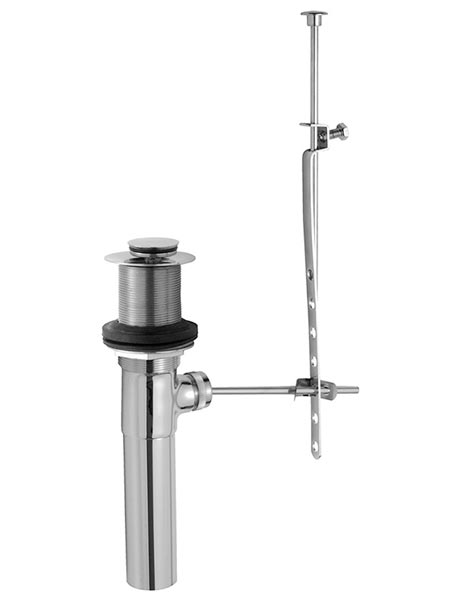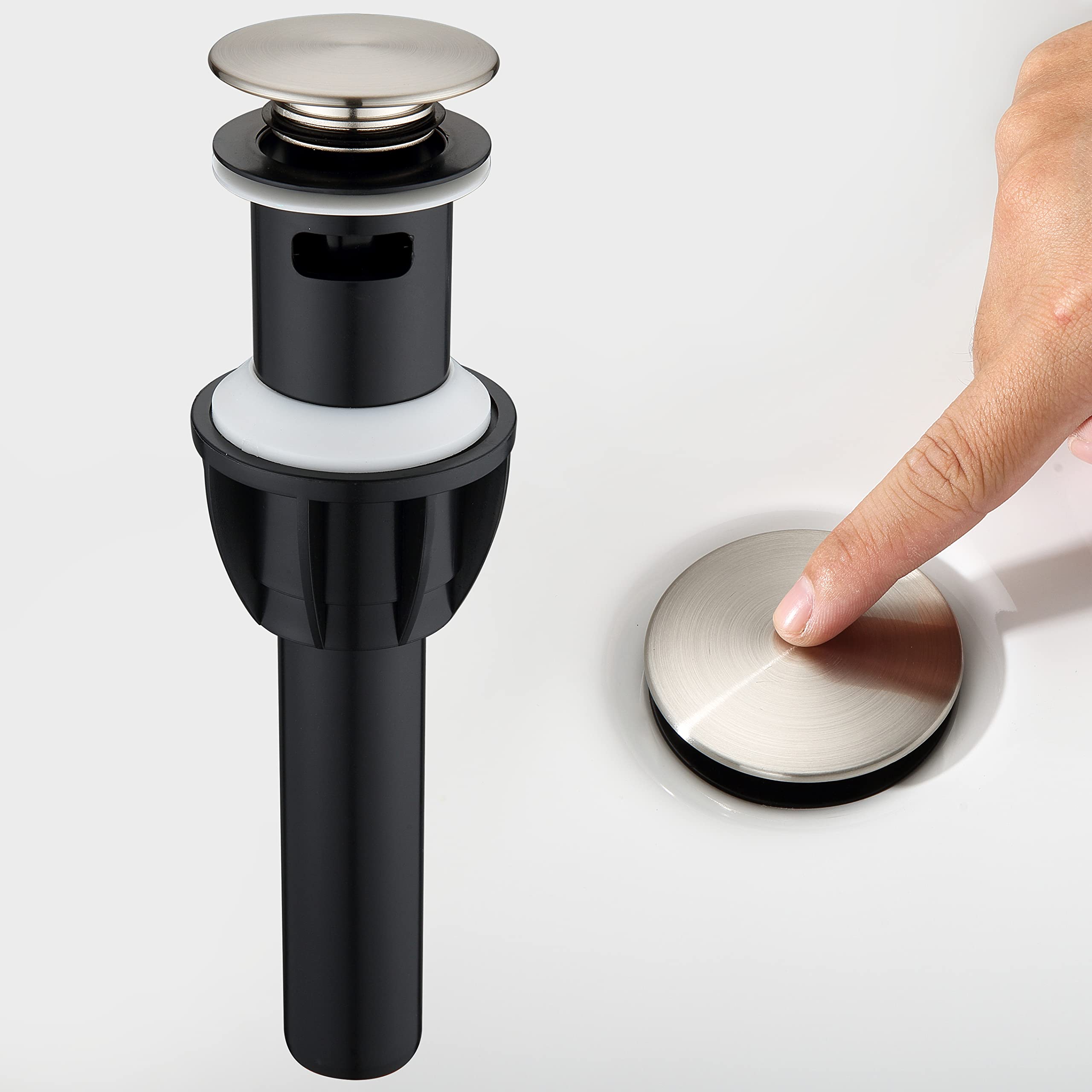A bathroom sink drain plug is a device that stops water from flowing down the drain. It allows you to fill the sink for tasks like washing hands or face.
The bathroom sink drain plug plays a crucial role in your daily routine. It ensures that water stays in the sink for various tasks, from shaving to washing dishes. Various types exist, including pop-up, lift-and-turn, and rubber plugs, each designed for specific sink styles.
Understanding the function and types of drain plugs can help you choose the right one for your bathroom. Regular maintenance of the drain plug prevents clogs and ensures smooth operation. Knowing how to install or replace a drain plug can save you time and money, enhancing your bathroom experience.
Introduction To Bathroom Sink Drain Plugs
Bathroom sink drain plugs play a crucial role in daily hygiene. They prevent water from flowing down the drain when filling the sink. Understanding how they work helps in maintaining a clean and functional bathroom.
Common Issues
Bathroom sink drain plugs can face various problems over time. Here are some common issues:
- Clogging: Hair and soap can build up around the plug.
- Leaks: Worn-out seals may cause water to leak.
- Sticking: Plugs may not open or close properly.
- Corrosion: Metal plugs can rust, affecting their performance.
Importance Of Maintenance
Regular maintenance of drain plugs is vital for several reasons:
- Prevents Clogs: Clearing debris keeps water flowing freely.
- Extends Lifespan: Regular checks prevent wear and tear.
- Saves Money: Early fixes avoid costly plumbing repairs.
- Improves Hygiene: Clean plugs reduce bacteria and odors.
Perform simple checks every few months. Replace worn parts promptly. A little care goes a long way in ensuring functionality.

Credit: www.plumbingsupply.com
Identifying Your Drain Plug Type
Choosing the right bathroom sink drain plug is essential. Knowing the type of plug can help with repairs and replacements. Here are the most common types of drain plugs.
Push-pull Plugs
Push-pull plugs are simple to use. They operate with a straightforward mechanism.
- Push down to close.
- Pull up to open.
These plugs are often found in older sinks. They are easy to install and maintain. Check for wear and tear to ensure proper function.
Lift-and-turn Plugs
Lift-and-turn plugs require a twist to operate. You lift the knob and turn it to open or close.
- Lift to open.
- Turn to close.
This type is popular in modern sinks. They provide a tight seal when closed. Keep the mechanism clean for smooth operation.
Pop-up Plugs
Pop-up plugs have a unique design. They use a lever or a rod to control the plug.
- Pull the lever up to open.
- Push it down to close.
These are common in contemporary bathrooms. They are stylish and functional. Regular cleaning ensures they work well.
Symptoms Of A Faulty Drain Plug
A faulty drain plug can cause several problems in your bathroom. Recognizing these symptoms early can help prevent bigger issues. Let’s explore the signs that indicate a drain plug might not be working properly.
Water Not Holding
One of the first signs of a faulty drain plug is water not holding in the sink. This can happen for several reasons:
- Worn-out or damaged rubber seal
- Incorrect installation
- Blockage preventing the plug from sealing
When water leaks out, it can lead to frustration. You may notice:
- Constantly emptying sink.
- Difficulty filling up the basin.
Slow Drainage
Another symptom is slow drainage. This can occur due to:
- A partially closed drain plug.
- Debris accumulation in the pipes.
- A malfunctioning drain mechanism.
Symptoms of slow drainage include:
- Water pooling in the sink.
- Taking longer to drain after use.
Difficulty In Operation
Lastly, you may experience difficulty in operating the drain plug. This includes:
- Struggling to open or close the plug.
- Feeling resistance when adjusting the plug.
These issues can arise from:
- Rust or corrosion on the mechanism.
- Improper alignment of the plug.
Addressing these symptoms promptly can save time and money.
Quick Fixes For A Stuck Plug
A stuck bathroom sink drain plug can be a hassle. It often leads to water pooling in your sink. Fortunately, there are quick fixes to resolve this issue. Below are effective methods to get that plug moving again.
Manual Adjustment
Sometimes, a simple manual adjustment can fix the problem.
- Locate the lever or chain connected to the plug.
- Gently pull or push the lever to see if the plug moves.
- Check if any visible debris is blocking the mechanism.
Using your fingers, you can carefully wiggle the plug. This may free it without any tools. If the plug remains stuck, try the next method.
Lubrication Techniques
Lubrication can help loosen a stuck drain plug.
- Use a few drops of dish soap.
- Apply a lubricant spray, like WD-40, around the plug.
Follow these steps for best results:
- Turn off the water supply.
- Apply the lubricant directly on the plug.
- Wait for a few minutes.
- Try adjusting the plug again.
Lubrication often works wonders for stuck plugs. It reduces friction and helps the plug move smoothly.
| Method | Steps |
|---|---|
| Manual Adjustment |
|
| Lubrication |
|
Try these quick fixes to tackle a stuck bathroom sink drain plug. They are simple and effective.
Cleaning And Maintenance Tips
Keeping your bathroom sink drain plug clean is crucial. Regular care helps prevent clogs. Here are some effective tips for cleaning and maintenance.
Regular Cleaning Schedule
Establish a cleaning routine for your sink drain plug. This will keep it free from debris and buildup.
- Daily: Rinse the drain plug with hot water.
- Weekly: Wipe down the plug with a soft cloth.
- Monthly: Remove the plug and clean it thoroughly.
Use a mixture of vinegar and baking soda for deep cleaning. Pour one cup of vinegar down the drain, followed by half a cup of baking soda. Let it fizz for a few minutes. Then, flush with hot water.
Avoiding Common Clogs
Preventing clogs saves time and frustration. Follow these tips to keep your drain running smoothly.
| Tip | Description |
|---|---|
| Use a drain screen | It catches hair and small debris. |
| Do not flush food | Food can cause serious blockages. |
| Regularly check the trap | Clean the trap to remove buildup. |
Keep chemical drain cleaners to a minimum. They can damage your plumbing. Opt for natural solutions instead.
Following these simple tips ensures a clean and functional bathroom sink drain plug.
Diy Replacement Of A Drain Plug
Replacing a bathroom sink drain plug can save time and money. It’s a simple task anyone can do. Follow these easy steps to complete the replacement yourself. This guide will help you avoid costly plumber fees.
Tools Needed
- New drain plug
- Adjustable wrench
- Screwdriver
- Pliers
- Plumber’s putty
- Bucket or container
Step-by-step Guide
- Turn Off Water Supply: Locate the shut-off valves under the sink. Turn them off.
- Place Bucket: Put a bucket under the sink to catch any water.
- Remove Old Plug: Use a wrench to unscrew the old drain plug. Carefully pull it out.
- Clean the Area: Wipe the drain area. Remove any debris or old putty.
- Apply Plumber’s Putty: Roll a small amount of putty. Place it around the new drain plug.
- Insert New Plug: Push the new drain plug into the drain. Ensure it fits snugly.
- Tighten the Locknut: Use a wrench to secure the locknut under the sink. Don’t overtighten.
- Reconnect Water Supply: Turn the shut-off valves back on. Check for leaks.
- Test the Drain: Fill the sink with water. Release the plug to ensure it drains properly.
Preventing Future Issues
Taking care of your bathroom sink drain plug is essential. It helps avoid clogs and leaks. Simple steps can save you time and money.
Proper Usage
Using your bathroom sink drain plug correctly ensures it lasts longer. Here are some tips:
- Keep it clean: Regularly remove hair and debris.
- Do not force it: If it gets stuck, gently wiggle it free.
- Use it wisely: Avoid putting heavy items on it.
Always check for damage. Replace the plug if you see cracks or wear.
Recommended Products
Choosing the right products can prevent issues. Here are some top choices:
| Product Name | Type | Features |
|---|---|---|
| EZ-Flo Rubber Stopper | Rubber Plug | Flexible, fits most sinks |
| Moen Push Down Plug | Push-Down | Easy to use, stylish design |
| PlumbCraft Pop-Up Assembly | Pop-Up | Durable, complete kit |
Investing in quality products avoids future headaches. Choose wisely to ensure a smooth experience.

Credit: www.amazon.com
When To Call A Professional
Knowing when to call a professional for your bathroom sink drain plug issues is crucial. Some problems are simple and can be solved at home. Others require expert attention. Understanding the signs can save you time and money.
Recognizing Complex Problems
Some drain plug issues are complicated. Here are signs you need a pro:
- Persistent Clogs: If your sink clogs often, it may indicate a deeper issue.
- Slow Draining: Water draining slowly can mean pipe damage.
- Unpleasant Odors: Foul smells often point to serious blockages.
- Frequent Backups: Water backing up in other drains indicates a plumbing issue.
These problems may worsen without professional help. Don’t ignore them.
Finding A Trusted Plumber
Finding a reliable plumber is essential. Use these tips to ensure you hire the right one:
- Check Reviews: Look for customer feedback online.
- Ask for Recommendations: Friends and family can suggest trusted professionals.
- Verify Credentials: Ensure they are licensed and insured.
- Get Multiple Quotes: Compare prices before making a decision.
Choosing the right plumber ensures quality work. It also prevents future issues with your bathroom sink drain plug.

Credit: m.youtube.com
Frequently Asked Questions
Can You Replace The Drain Plug In A Bathroom Sink?
Yes, you can replace the drain plug in a bathroom sink. First, remove the old plug by unscrewing it. Then, install the new plug by following the manufacturer’s instructions. Ensure a tight fit to prevent leaks. Regular maintenance helps keep the sink functioning properly.
Are Bathroom Sink Plugs A Standard Size?
Bathroom sink plugs are not a standard size. Sizes vary based on sink type and manufacturer. Always measure your sink’s drain hole before purchasing a plug. This ensures a proper fit and prevents leaks. Check product specifications for compatibility to avoid any issues.
What Is The Bathroom Sink Stopper Called?
The bathroom sink stopper is commonly called a “drain stopper” or “sink plug. ” It prevents water from draining and can come in various types, including pop-up, lift-and-turn, and flat stoppers. Each type serves the same basic function of controlling water flow in the sink.
How To Replace Sink Stopper In Bathroom Sink?
To replace a sink stopper, first remove the old stopper by unscrewing the retaining nut. Clean the sink drain and insert the new stopper. Secure it by tightening the retaining nut. Test the stopper to ensure it opens and closes properly.
Enjoy your fully functioning bathroom sink!
Conclusion
Choosing the right bathroom sink drain plug is essential for functionality and style. Consider materials, designs, and compatibility with your sink. A well-selected plug enhances your bathroom’s aesthetics while preventing leaks. Invest time in your choice to ensure long-lasting performance and satisfaction.
Enjoy a seamless bathroom experience with the perfect drain plug.
